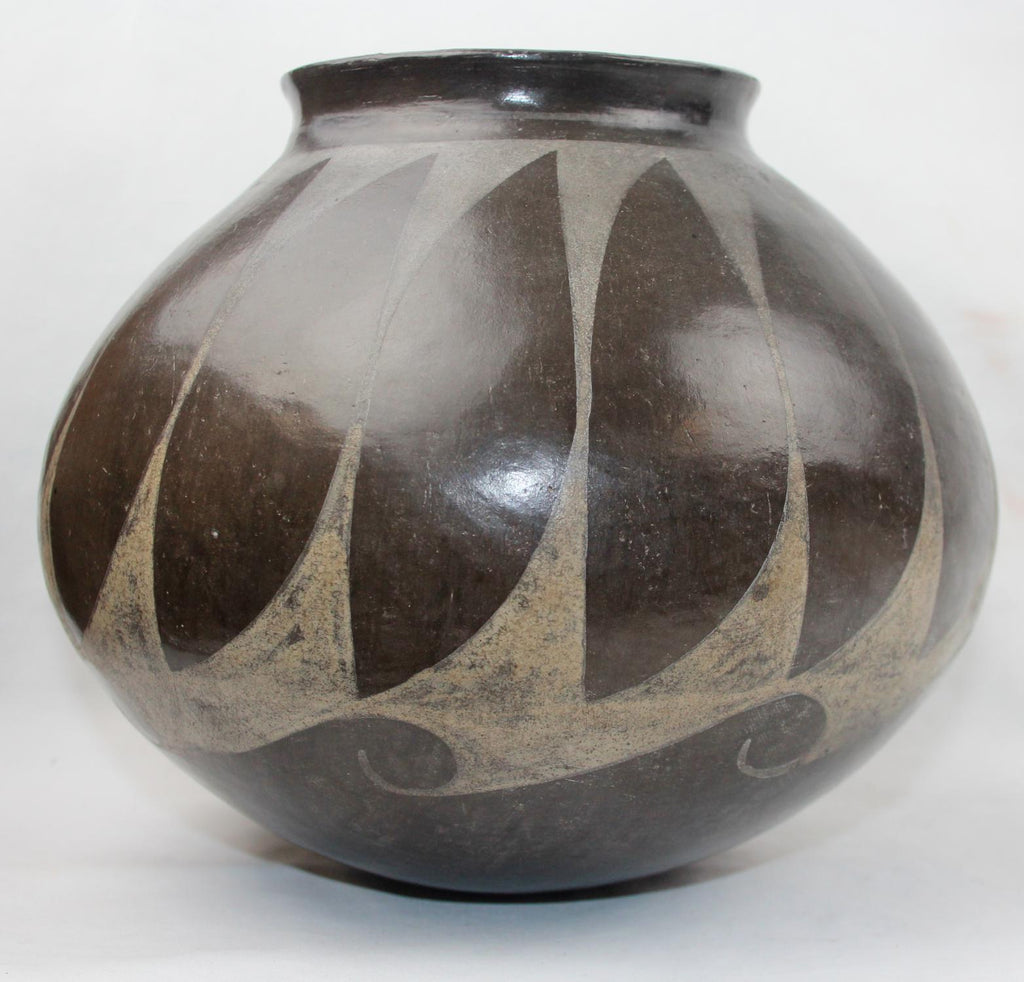
Vintage Mata Ortiz Blackware Olla, by E Ortiz, Mid 19th Century, #1437 SOLD
$ 1,250.00
Vintage Mata Ortiz Blackware Olla, by E Ortiz, Mid 19th Century, #1437
Description: #1437 Vintage Mata Ortiz Blackware Olla, by E Ortiz, Mid 19th Century. Decorated in the round with repeating feather pattern, signed to underside, E. Ortiz.
Dimensions: 8"h x 8"dia
Provenance: Property removed from 2 Beekman Place, NYC
Condition: Excellent for its age
Seven hundred years ago, Casas Grandes civilization flourished for several centuries in what would become Mexico. The center of Casas Grandes, a city we call Paquime, stood near the site of present-day Mata Ortiz, Chihuahua. A number of Casas Grandes people were exceptional artists and left a legacy of fine ceramics. In the twentieth century, a loosely aligned league of Mexican potters, Manuel Olivas, Emeterio Ortiz, Felix Ortiz, Salvador Ortiz, Juan Quezada, Nicolas Quezada, Nicolas Silveira, Rojelio Silveira and others, pioneered the renaissance of Casas Grandes ceramics, now known as Mata Ortiz Pottery.
Visitors from the United States played important roles in making the pottery known to people north of the border. Still, as artist Juan Quezada suggests in the Journal of the Southwest, the potters of Mata Ortiz were destined for success with or without connections to any particular agents. Mata Ortiz Pottery was already on the road to greatness when strangers arrived. Mexicans, working together and learning from one another, brought forth the rebirth of Casas Grandes pottery. It took a village, a Mexican village. (Source: Mata Ortiz Broadcast)
Description: #1437 Vintage Mata Ortiz Blackware Olla, by E Ortiz, Mid 19th Century. Decorated in the round with repeating feather pattern, signed to underside, E. Ortiz.
Dimensions: 8"h x 8"dia
Provenance: Property removed from 2 Beekman Place, NYC
Condition: Excellent for its age
Seven hundred years ago, Casas Grandes civilization flourished for several centuries in what would become Mexico. The center of Casas Grandes, a city we call Paquime, stood near the site of present-day Mata Ortiz, Chihuahua. A number of Casas Grandes people were exceptional artists and left a legacy of fine ceramics. In the twentieth century, a loosely aligned league of Mexican potters, Manuel Olivas, Emeterio Ortiz, Felix Ortiz, Salvador Ortiz, Juan Quezada, Nicolas Quezada, Nicolas Silveira, Rojelio Silveira and others, pioneered the renaissance of Casas Grandes ceramics, now known as Mata Ortiz Pottery.
Visitors from the United States played important roles in making the pottery known to people north of the border. Still, as artist Juan Quezada suggests in the Journal of the Southwest, the potters of Mata Ortiz were destined for success with or without connections to any particular agents. Mata Ortiz Pottery was already on the road to greatness when strangers arrived. Mexicans, working together and learning from one another, brought forth the rebirth of Casas Grandes pottery. It took a village, a Mexican village. (Source: Mata Ortiz Broadcast)
Related Products
Sold out
Sold out











